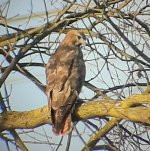Hi everyone,
last Sunday, I took this picture of a buzzard near Cologne in Germany.

When it flew up to the branch it sits on in the picture, I noticed that the tail was a very warm brown. So I set up scope while the buzzard patiently waited, keeping an eye on me all the time
It doesn't look like any Common Buzzard I've seen before, and ssp. vulpinus seems to be unlikely in Germany, while some of photographs I found of Long-legged Buzzards (which I've never seen before) almost look like the one of my mystery bird.
So, could this be a Long-legged Buzzard?
Many thanks in advance!
Regards,
Henning
last Sunday, I took this picture of a buzzard near Cologne in Germany.

When it flew up to the branch it sits on in the picture, I noticed that the tail was a very warm brown. So I set up scope while the buzzard patiently waited, keeping an eye on me all the time
It doesn't look like any Common Buzzard I've seen before, and ssp. vulpinus seems to be unlikely in Germany, while some of photographs I found of Long-legged Buzzards (which I've never seen before) almost look like the one of my mystery bird.
So, could this be a Long-legged Buzzard?
Many thanks in advance!
Regards,
Henning




